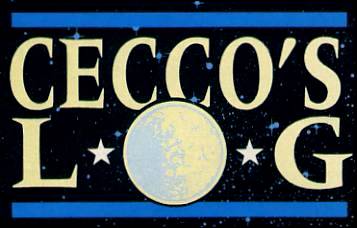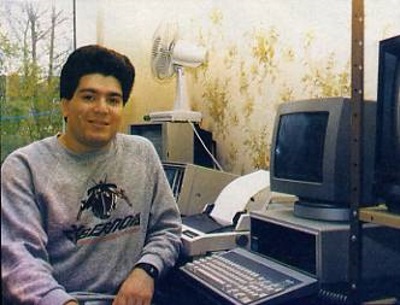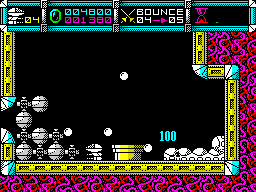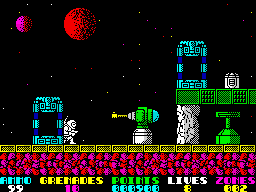
Following the success of his latest masterpiece, Cybernoid, Rafaelle Cecco has been kind enough to let us in on the trials and tribulations that occur during the programming of his next game. Over the coming months he’ll be relating his day-to-day problems and triumphs as he battles against attributes, software sprites and Z80 machine code in a binary journey into the future...

Just when I thought it was safe to come out of hibernation after the completion of Cybernoid, the dreaded phone rings and I am greeted by Andrew Hewson’s dulcet tones: ‘Hello Raf, fancy doing this diary thing for CRASH?’. To which I reply, still wiping the sleep from my eyes, ‘Well... er... um... I...’
‘Great stuff Raf, I knew you wouldn’t let me down — bye!’
Never being one to turn down such a challenge (especially when it’s been rammed down my throat). I decide that it would be an interesting task after all.

In a short moment of relaxation Raffaele blow dries his hair...
I may as well start by getting the boring stuff out of the way, ie — me. I come from Tottenham in North London (or ‘Norf’ London as we say in that neck of the woods). I’m 20 years old and started programming on a ZX81 (surprise, surprise). Games that I have programmed in the past include Equinox, Copout, Solomon’s Key, Exolon, and most recently, Cybernoid.
After leaving school with a handful of useless qualifications, I slaved over a hot terminal at the now defunct Mikro-Gen for a year but soon became tired of the ‘in-house’ atmosphere. I went freelance after leading a violent and bloody programmers’ revolution. I still bear the mental scars and personality disorders to this day as I was only n-n-nineteen at the time.
As you can see from the photographs, a lot more equipment is used in developing Spectrum games than a single Spectrum and cassette-based assembler! The Spectrum is actually developed on an IBM compatible PC which runs a fast Z80 cross-assembler that can compile a 200K source file in a few seconds. After the program has been assembled, it can be downloaded to the Spectrum via a parallel link, ready for testing.
The graphics are all designed on an Atari ST using the Advanced Art Studio. This package (programmed by my good friend Chris ‘8-bits are crap’ Hinsley) also features a ‘map editor’ that enables all the screens in a game to be chopped and changed very quickly. The ST format graphics are converted to Spectrum format data to be incorporated into the main program.
This type of set-up has many advantages over developing the program on the Spectrum itself. For a start you never have to worry about the Spectrum crashing, as the program is permanently stored on the PC’s hard disk. The program’s development time is cut down by a huge amount. The same set-up can be used to program virtually any micro — the Amstrad CPC conversion was completed in less than two days after the Spectrum one.
The aim of this diary is to document all the successes, failures and mixed emotions that are part and parcel of developing new games. Just to whet your appetite, the project (as yet without a name) that you’ll be witnessing is intended to develop into a full colour, scrolling, ‘blast and think’ (with the emphasis on blast!) type of game. There are some new and exciting ideas that Andrew Hewson and I have discussed for inclusion in the program; more about these in the months to come.
I am graced by the ominous presence of Andrew Hewson and my bosom buddy/Commodore 64 programmer, Nick Jones (who will be doing the C64 conversion). We discuss (argue about) the game and I am given a sample contract to study (Yes, I actually get paid for doing this sort of thing.)
After many cups of tea and a few bouts of arm twisting and Chinese burns, we decide that a fantasy/fairytale setting would make an interesting departure from the usual science-fiction ambience that my past games have tended to carry. This would also allow great scope for some snazzy graphics — and let my imagination run riot.

The setup as Raf sees it (L to R): Atari 1040 ST, Philips CP/M System, Citizen 120D printer and Olivetti PC
I ponder over the significance of yesterday’s meeting and decide that a long spell in bed will help me get over it.
Knowing that the game is to be scrolling, I have a fiddle on the PC, trying to weigh up the problems of horizontal scrolling on a Spectrum. Hmmmm, this is going to be a little harder than I thought: for a start the attributes will have to be deviously arranged to avoid colour-clash problems. I think that monochrome games are undesirable on a computer which can support eight colours.
I spent most of today trying to decode the contract which has obviously been written in solicitor-speak (double-dutch). It’s amazing just how horrendously professional this business has become; a single game involves not only programmers and programming but advertising, distributors, release schedules, public relations, artists, musicians and all manner of weird and wonderful people.
I discuss the finer points of the contract with Andrew on the ’phone.

Andrew Hewson turns up yet again, waving the contract in my face (on a Saturday morning for God’s sake!). I pretend that I’ve changed my mind about the whole thing but Andrew manages to see through my pathetic facade and we both sign on the dotted line. With tongue firmly in cheek, my girlfriend takes photographs of the historic Cecco/Hewson contract.
I decide to spring-clean my office ready for some hard core programming next week. Phew! Two massive sackfuls of rubbish, program listings and old magazines are thrown out. The amount of mess I create during the development of a program can be quite alarming at times.
I study Zynaps closely as this is the game that I consider to have the most outstanding scrolling on the Spectrum. Sometimes it’s difficult to believe that the Spectrum has no hardware assistance. It’s always worth checking out other games to generate a bit of competitive zeal.

I’ve begun rewriting my graphics converter utilities to work on the Spectrum itself, rather than on my weather-beaten Philips CPM system. I used this old fogey to develop all my games right up to Exolon. It has now been superseded by the faster IBM compatible PC. I’ll probably use the Philips as a giant door-stop or something. Any offers for the old beast will be greatly appreciated.
I am being pestered to get this diary completed — give ’em an inch and they’ll take a mile. Nick Jones suggests a terrific way of improving the scrolling routine. It imposes a few limitations on how I can arrange the graphics, but it’s well worth the sacrifice for the extra speed.
Well, that’s it for this month. Next issue I’ll be concentrating more on the program itself and, all being well, will have an up-and-running demo to show off.